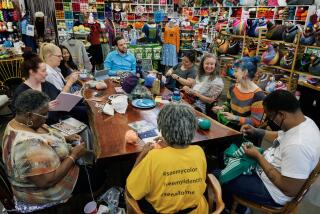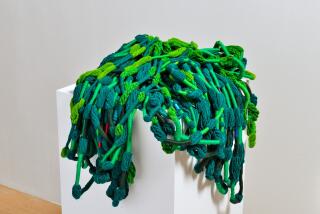ARTISANS : Tapestries Make Their Point Anew in Revival of Needlework Crafts
- Share via
In intricate tapestries that hang as artworks and in decorative pillows adorning sofas, the ancient art of needlepoint is making a new name for itself.
As in earlier periods, needlepoint pieces are being used to add richness and texture to rooms.
There are those who prefer to buy the works of others, but often enough, individuals are doing the needlework themselves.
For more than 17 years, Chris Demopoulos and his wife, Rose, who own Velona Needlecraft in Anaheim Hills, have taught this art to young and old alike. The craft, popularized in the 16th Century, is gaining new attention now because of the range of projects available and the wider availability of materials.
“We have children as young as 5 working on projects and many senior citizens in their 90s,” Chris Demopoulos said. “People who do needlepoint represent just about every nationality and lifestyle. Our customers include surgeons, truck drivers, athletes--you name it. What many find appealing about this work is that it can be as easy or as difficult as you like.”
Needlepoint essentially consists of weaving threads through a canvas mesh. The term needlepoint caught on in the 1930s, when what had been known as canvas embroidery gained popularity in America. European importers decided to create a catchy name for this art and it’s had that moniker ever since.
“We’ve always sold needlepoint items,” said Linda Boyd, owner of the gift shop St. Ives et Cie in Irvine, “but there does seem to be an increased popularity now.”
Among the items most popular in Boyd’s shop are pillows and rugs. Motifs of flowers, animals and still-lifes are the most requested.
“I think people appreciate needlepoint not only for its beauty but for the time involved to create it,” said Priscilla Garcia, a sales associate at St. Ives. “Most of our customers put the pillows or rugs in areas where people congregate, such as living rooms or family rooms, so everyone can enjoy them.”
Demopoulos says most beginners start with simple patterns, often ones that have been screened on a piece of canvas mesh. The mesh size is determined by the number of openings per inch. For example, an 18-inch mesh has 18 openings per inch; a five-inch mesh canvas (also referred to as rug canvas) will have much larger openings. For children or those with vision problems, a canvas with a wide mesh is recommended.
“We have some kits designed specifically for children, with very large holes and a large plastic needle so they can’t hurt themselves,” Demopoulos said. “They start at about $3.50, so there isn’t a significant investment if the child is too easily frustrated.”
Many needlepoint enthusiasts get their start as children, but others are adults before they begin putting thread to canvas.
“We had one customer who was 74 when she did her first canvas,” Demopoulos said. “Once she got started, she was hooked. She did many more intricate pieces, combining different stitches and fibers.”
There are a number of options available to today’s needlepoint artisan, to working free-style or from detailed kits.
One of the most dramatic of the needlepoint options is trame, a style typically used to reproduce artistic masterpieces in tapestry scale. Work based on Rubens, Renoir, Van Dyck, Raphael or scenes of biblical or historical significance can be found.
The trame canvas generally has small details (such as faces) already stitched in extremely precise small stitches known as petit point or extra fine micro point. The surrounding scenes are outlined in long stitch with yarn in the corresponding colors. The needlepoint worker then follows the pattern of the long stitches and weaves more precise, even stitches directly over the loose long stitches.
“Those who like trame tend to appreciate great art,” Demopoulos said. “They enjoy these great paintings, but there’s no way they could afford an original and a print wouldn’t mean as much to them. By creating a tapestry-like work, it’s as though they can have a bit of the original.”
Although trame pieces tend to be larger and more impressive looking, they aren’t necessary any harder to create, Demopoulos said.
“The stitching is the same for trame as it is for many of the kits we sell,” he said. “It often takes longer because the pieces are larger, but it’s no more difficult.”
Other needlepoint artisans prefer to work with a hand-painted canvas. These are different from the mass-produced images available in kits. Each hand-painted canvas is done by one person who colors the canvas very precisely so that it follows the breaks of the canvas. These tend to be a bit more expensive than kits because the precision is so exact and because each is drawn and colored individually.
“While most of the pieces from kits look fine, because they’re made by the thousands, the lines may be a little off the canvas,” Demopoulos said. “Others like the idea that they have something unique that isn’t mass-produced. It takes time for an artist to color each canvas, and there are sometimes subtle variations from one canvas to another.”
Most kits also supply the yarns and threads. With hand-painted canvases, customers are free to select those fibers they prefer.
Of course, some workers like selecting blank canvases and creating their own designs.
*
One of the biggest mistakes beginning needlepointers make is buying poor quality yarns and canvases, Demopoulos said.
“Poor quality canvas can tear or become misshapen very easily. Poor yarns and threads have a greater risk of snapping or fading over time. If someone is going to take the time to create a needlepoint piece, it should be something that can be appreciated for years.
“Higher-quality fibers will also make the finished piece look nicer. Sometimes there are variations in inexpensive kits that can make subtle changes in the finished piece. Many families like to hand needlepoint pieces down through the generations, so it makes sense to start with high-quality materials.”
Another common mistake many beginners make is not washing their hands before working on their projects.
“We have people who will read the newspaper, set it down and then pick up their needlepoint,” he said. “The newsprint will rub off on the fibers. I always recommend washing your hands before starting to work on a project and if possible, start working with the darkest colors first and work your way up to the lightest.”
*
For those who enjoy the look of
needlepoint but don’t have the time or inclination to handcraft these items, there is always the option of buying a finished piece. Prepare to spend between $30 to $60 for a small pillow. Rugs begin at $165 for a piece measuring two by three feet, and $325 and up for rugs measuring three by five feet.
The fact that needlepoint is becoming appreciated once again isn’t surprising to Demopoulos. He sees it as a reflection of the lasting beauty of the craft and the investment of time that each piece represents.
“When you finish a needlepoint project, there’s a tangible reward. It’s something to be valued and perhaps passed down through the generations,” Demopoulos said.
“Once people get started with needlepoint,” he says, “they may move on to other needle-craft projects from time to time, but it seems like people always come back. There’s something enduring about needlepoint that makes people keep stitching.”
More to Read
The biggest entertainment stories
Get our big stories about Hollywood, film, television, music, arts, culture and more right in your inbox as soon as they publish.
You may occasionally receive promotional content from the Los Angeles Times.










